We've been amazed by the amount and diversity of snail species in Cuc Phuong. We knew it was rich but we have found so many new and exciting species that we are struggling to process all the material (a good problem to have). The weather has improved slightly (good for us) but the ground and leaf litter is still really damp for collecting (good for the snails, everyone wins!).
Limestone outcrops in Cuc Phuong National Park, the perfect habitat for a snail hunt.
Megaustenia sp. is a semi-slug, see how the body (also called the mantle) almost completely covers the shell.
I can't wait to get back to the Museum to try and identify this large, keeled Camaenid.
Paul Pearce Kelly, the Senior Curator of Invertebrates and Lower Vertebrates at London Zoo, is joining us on field work for the first time. His aim (apart from helping us to collect snails) is to build up links with different groups in Vietnam to help conserve and study threatened species.
After finding some thought-to-be-extinct snails on our Vietnam trip in 2012, we hope that Paul, in conjunction with the Vietnam National Museum of Nature, will be able to set up a breeding programme to protect them against threats in future. As well as helping us collect, Paul took some great videos of animals alive in the field and he has kindly let me share them with you in my blog. In this one you can see the as yet unidentified 'looping snail':
The as yet unidentified 'looping snail'. See how only a small portion of the foot is in contact with the rock at any one time.
Another member of our group I'd like to introduce to you to is Jonathan Fenn, a biology placement student from Manchester University. Jonathan has been working with Fred and I for the past year on producing an illustrated guide of the slugs and snails of Northern Vietnam, as well as a species list with distribution data for terrestrial molluscs across the whole of Vietnam. The aim of the trip is to teach Jonathan more about fieldwork, collecting and preserving snails, and to gain experience in preserving viable cells (which I will discuss in my next blog).
 Sang van Pham and Paul Pearce Kelly (left) in the national park, and Jonathan Fenn in collecting mode.
Sang van Pham and Paul Pearce Kelly (left) in the national park, and Jonathan Fenn in collecting mode.
As well as snails, the forests and local areas are home to an amazing array of different animals. One of my favourites (not including the enormous spider that lives in my toilet, didn't think you would want a picture of that) was the praying mantis species I found outside my bedroom (see below). Sadly I missed the Vine Snake (Ahaetulla sp.) that my co-workers found when searching the trees for snails.
"What you lookin' at?"
So gutted I missed this Vine Snake (Ahaetulla sp.), what a beauty!
Since we'd all been working so hard we decided we deserved a visit to the Endangered Primate Rescue Center (EPRC) in Cuc Phuong National Park. The centre was established in 1993 and is dedicated to the rehabilitation, breeding and research of endangered primates as well as the protection of their habitats. The EPRC is home to over 150 primates from 15 Vietnamese species, including lorises, langurs and gibbons. My favourites were the wonderfully playful Gray Shanked Douc Langurs.
Grey Shanked Douc Langur family (Pygathrix cinerea), a critically endangered species endemic to Vietnam.
Some of the team with Liam Shepheard (centre in Green T-shirt), one of the head animal keepers at the Endangered Primate Rescue Center.
Our guide for the afternoon was Liam Shepheard, head animal keeper, who showed us the remarkable centre and told us about the amazing work they do in rescuing and when possible re-introducing animals back in to the wild. One species of Laotian Langur (Trachypithecus laotum) named 'Airport' is the only individual of its kind in captivity and is thought to be critically endangered in the wild. At times the stories were a sad and sobering experience but the success they are having is remarkable and it was real treat to be able to see these beautiful creatures up close.
Carnivore and Pangolin Rescue Center
After meeting the directors of Cuc Phong National Park over dinner the previous evening, we were invited to visit the Carnivore and Pangolin Rescue Center, a massive privilege as this is not normally open to the public. Many mammal species are being hunted for meat, the pet trade and in the case of the Pangolin, for Chinese medicine (the scales are used in medicines and the meat is regarded as a, ahem, male performance enhancer). The centre was set up to rescue illegally found animals and to develop techniques and procedures to allow the rehabilitation, breeding and reintroduction of such species back in to the wild.
We visited the centre at night, which is the best time to see the majority of the animals. Pangolins are my favourite mammal and I have never seen one before so this was a real highlight for me. The animal we met was called 'Lucky', a Sunda Pangolin who had been saved from captivity but who was sadly too tame to be re-introduced.
The Binturong (Arctictis binturong) - the cutest thing I have ever seen. Numbers have dropped due to hunting.
A Sunda Pangolin (Manis javanica) rescued from an illegal trader but sadly too tame to be released.
I also got to see another favourite of mine, the Binturong, a south-east Asian mammal related to civets whose numbers have been declining in the region due to threats from poachers.
A Few Thoughts from my Stomach
We have had some delicious and some challenging food in the last few days. Fried mixed mushrooms and chilli roasted chicken have been superb, whereas mixed offal and pak choi soup was something I am keen to avoid in the future (and I like offal). But today I thought I would tell you a bit about some of the mealtime extras I have enjoyed.
Nu?c ch?m is the name of a group of dipping sauces that are commonly served with meals that have a fish sauce base, often mixed with garlic, bird's eye chillis, garlic and sugar, with the precise mixture depending on the region. This sauce is, I think, delicious with morning glory and .. well, actually pretty much anything although a few of our group find it a bit overpowering (I would take some home but it is prohibited by most airlines as if it leaks it tends to smell forever!)
At the behest of our Vietnamese colleagues of course, we like to round the day off with a glass or two of Mountain Apple Brandy. The precise ingredients of this sour but delicious beverage are a closely guarded secret, and it is homemade by the wife of our driver, Mr. Kiem. I have however managed to find out that it contains a sour apple-like fruit, rice wine, mixed berries and a selection of herbs and bark. Whatever it is I'm sold!
Bite Count
0 Leech Bites (I cannot tell you how happy this makes me)
8 Mosquito Bites (in total, 5 new ones)
More Ant bites than a man should ever have to deal with! Itchy does not even come close.



